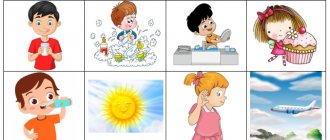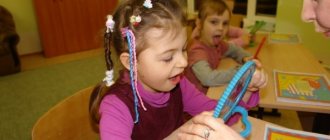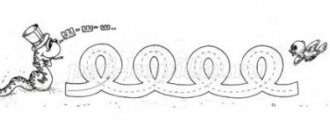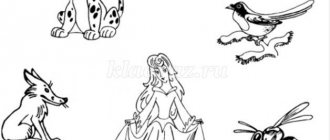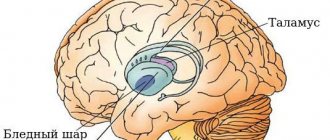Making the sound “r”Game fragments of individual lessons
Making the “r” sound often takes a long time. The child must be prepared to correctly perceive and reproduce sound.
Repeating the same material over and over again gets boring. However, repetitions are necessary: you need to work out the correct articulation pattern, teach the child to hear, recognize the sound, and then pronounce it correctly.
When conducting an individual lesson, it is important to remember that the child must have a persistent positive emotional attitude throughout the entire lesson, which is expressed in the desire to study. How to interest a child and make him want to repeat articulation exercises again and again?
I offer several game fragments of individual lessons, the main goal of which is to prepare for the production of the “r” sound.
Game techniques allow you to maintain the child’s interest over a certain period of time. In addition, they allow you to solve such important problems as:
— development of articulatory motor skills, formation of precise movements of the organs of the articulatory apparatus;
— development of phonemic perception;
— development of fine motor skills of the hands;
— activation of mental activity, development of voluntary attention and memory.
Fragment 1.
1. Report the topic of the lesson.
Listen to the riddle and find the answer among the three pictures (there are three pictures in front of the child, one has a cancer ).
Who lives in the river sand,
Walking backwards? (Cancer.)
Show the picture of the answer.
Make the letter from the peas that the word “cancer” begins with (if the child can read).
Place as many peas as there are sounds in the word “cancer”. Do the math.
2. Development of auditory attention and phonemic perception.
A) Listen to what I call this picture. Am I calling it correctly? Answer “yes” or “no”.
Ryak, lak, rak, ak, yak, rak, gak, rak, etc.
B) Game “Catch the Sound” - isolating the sound “r” (with a clap) from a number of sounds, syllables, words: r, b, zh, r...; ra, zha, bu, ry, ar, am, ur...; cancer, frost, cat, hedgehog, games, axe, suitcase.
3. Clarification of the articulation of the sound “r”: lips are free; the teeth are close together, but not touching; the tip of the tongue is raised to the tubercles behind the upper teeth and vibrates; there is a warm air stream in the middle of the tongue; the neck "works".
4. Introduction to articulation and breathing exercises: “Brushing the upper teeth”, “Swing”, “Painter”, “Delicious jam”, “Turkey”, “Horse”, “Mushroom”, “Accordion”, “Drum”, “Beat” the ball is in the goal."
5. Making the sound “r”: by imitation, from the “Mushroom” exercise, with mechanical assistance ( if the state of articulatory motor skills allows) .
Fragment 2.
1. Graphic dictation: 3 cells left, 2 up, 3 right, 2 up, 6 right, 2 down, 3 right, 2 down, 3 left.
- What happened? (Car.) Draw the wheels.
- What kind of car is there? Choose a sign word (car, truck, big, small, shiny, white, black, old, new, dirty, clean, etc.).
- What does the machine do? Choose an action word (driving, standing, buzzing, making noise, slipping, etc.)
— The car drives and buzzes: trrrrr. Let's continue to learn how to pronounce the sound "r".
2. Development of phonemic awareness.
The car is driving, buzzing. As soon as you hear the sound “r”, clap your hands once: r, b, f, r...; ra, zha, bu, ry, ar, am, ur...; cancer, frost, cat, hedgehog, games, axe, suitcase.
3. To make the car start easily, we will do articulation gymnastics: “Cleaning the upper teeth”, “Swing”, “Painter”, “Delicious jam”, “Turkey”, “Horse”, “Mushroom”, “Accordion”, “Drum”, "Kick the ball into the goal."
4. Setting the sound “r”: by imitation, with mechanical assistance, from the “Mushroom” exercise ( if the state of articulatory motor skills allows) .
Fragment 3.
1. Development of fine motor skills.
Guess the riddle: “What kind of bird? He doesn’t sing songs, he doesn’t build nests, but he carries cargo and people.” (Airplane) Lay out an airplane using matches according to the pattern.
2. Development of phonemic awareness.
The plane is flying, the engine is roaring. When you hear the sound “r”, clap your hands once: u, a, r, w, k, s, r, g, o, i, r, v, e, r, bu, ar, ko, gy, ha , ur, pu, ry, ho, ur.
3. Articulation and breathing exercises: “Brushing the upper teeth”, “Swing”, “Painter”, “Delicious jam”, “Turkey”, “Horse”, “Mushroom”, “Accordion”, “Drum”, “Kick the ball in” gates".
4. Making the sound “r”: by imitation, from the “Mushroom” exercise, with mechanical help.
Now start the plane's engine yourself.
Fragment 4.
1. Report the topic of the lesson.
Guess the riddles:
The tail is a hook, the nose is a snout ( pig ).
The squirrel lives in the trees and gnaws nuts .
He squeaks above his ear all night. And I don’t mind biting you. What a bore, what a nightmare. Squeaky, small...( mosquito ).
Red-haired, fluffy, cunning, carries chickens ( fox ).
Remember and name all 4 guess words. Who is the odd one out here and why? (Mosquito, because a mosquito is not an animal, but an insect).
Today we will learn to ring like a big mosquito.
2. Articulation and breathing exercises: “Brushing the upper teeth”, “Swing”, “Painter”, “Delicious jam”, “Turkey”, “Horse”, “Mushroom”, “Accordion”, “Drum”, “Kick the ball in” gates".
3. Setting the sound “r”.
Smile, open your mouth, lift your tongue up and make the sound “z” - ring like a mosquito. Runs several times.
A picture of a mosquito with missing parts is shown.
Look, it's a mosquito. Remember what he looks like. Now close your eyes. The missing details are completed.
What changed?
Let's ring 10 more times like a mosquito.
Now the mosquito flies along the paths (we draw five paths, at the end of which the letters a, s, o, y, e ). Run your finger along the “paths” and say za, zy, zo, zu, ze (the tip of the tongue is behind the upper incisors).
Fragment 5.
1. Report the topic of the lesson.
Game “Who will be who (what)?”: egg - chicken, chicken - chicken, boy - ..., acorn - ..., egg - ..., caterpillar - ..., iron - ..., bricks - ..., fabric - ..., leather - ... , sick - ..., weak - strong.
To learn to pronounce the sound “r”, we must make the tongue strong. Let's do some articulation exercises.
2. Articulation and breathing exercises: “Brushing the upper teeth”, “Swing”, “Painter”, “Delicious jam”, “Turkey”, “Horse”, “Mushroom”, “Accordion”, “Drum”, “Kick the ball in” gates".
3. Development of phonemic perception + production of the sound “r”.
A coloring picture “mosquito” is shown.
Here's a mosquito. Remember how it rings and ring it 10 times.
Let's make the mosquito beautiful, color it, but we will choose only those colors that have the sound “r” in their name.
So, will the wings be blue or red, the body orange or yellow, the head black or blue?
Look how bright our mosquito has become. He's very happy. Ring 10 times joyfully.
Now the joyful mosquito flew to the flowers (we draw flowers with the letters a, s, o, y, e ). Move your finger along the “paths” and say za, zy, zo, zu, ze .
Now let’s tickle our mosquito (setting the “r” with mechanical assistance).
Summary of an individual speech therapy lesson on sound production [r].
Individual speech therapy session on sound production
[r].
Subject:
Setting the sound [r].
Target:
learn to pronounce the sound [r] correctly with mechanical help.
Tasks:
Correctional and developmental:
- develop phonemic processes;
- develop articulatory and fine motor skills;
- develop attention and memory.
Educational
- learn to isolate the sound [r] from a number of words;
- learn to form possessive adjectives;
- practice the correct use of case forms of nouns.
Educational:
- cultivate interest in the activity and the ability to concentrate.
Equipment:
a mirror, a Tiger Cub toy, a speech therapy umbrella with a ball or a stick with a pacifier on top for setting the sound [p], object pictures with symbols on the back, a set of geometric shapes, counting sticks, pictures of animals.
Progress of the lesson
1. Organizational moment.
-Today I want to introduce you to a little tiger cub who lives in the zoo with his tiger mother. Mom let him go with me so that the baby tiger could learn to roar. You also learn to pronounce the sound [r] correctly. This means you can help each other.
2. Main part. Articulation and breathing exercises.
-First you need to stretch and prepare your tongue well. Show the tiger cub what exercises need to be done for this.
(The child performs articulatory gymnastics using pictures indicating the names of exercises for the tongue “Cup”, “Swing”, “Delicious Jam”, “Painter”, “Horse”, Fungus”, “Drummer” and the air stream “Twirler”, “Sail” ).
3.
Articulation of sound [r] . Repetition of the correct articulation of the sound [r].
-The tiger cub became very interested in his reflection in the mirror while we performed and showed him the exercises. Show the correct articulation of the sound [r].
- lips stretched in a smile;
- teeth at some distance from each other;
- the tip of the tongue is raised to the alveoli and vibrates;
— in the middle of the tongue there is a strong air stream, which we feel in the palm of our hand.
(several times the speech therapist and the child practice the correct articulation of the sound [p]).
4.Making the sound “R” with mechanical assistance.
“Our tongues are tired, but let’s take a walk with the tiger cub.” Look, a tractor is driving along the road and rumbles loudly and loudly. Show the tiger cub how a tractor works, and I will help you with our magic wand with a pacifier. Say quickly a long series of “dddd” (At this time, with a pacifier placed under the tip of the tongue, the speech therapist makes frequent oscillatory movements from side to side, resulting in a rumble characteristic of the pronunciation of the sound [r]).
5.
Game for the development of phonemic hearing “Give me a detail”
.
-A little further, the driver is repairing the car, looking for the necessary parts. Help him, give him only the part whose name contains the sound “r”. And the tiger cub will help you. (The speech therapist offers parts - geometric shapes - and pronounces a number of words: starter, spark plug, generator, chain, headlight, steering wheel, light bulb, muffler, filter. The child must take the part that the speech therapist accompanies the word with the sound [r]).
6. Staging the sound
[p] with mechanical assistance.
-The driver repaired the car and started the engine. Show the tiger cub how the motor works (producing the sound [r] with mechanical assistance).
7. Game for the development of visual attention and memory “Remember the road.”
-The tiger cub ran after the car along the road. To prevent him from getting lost, help him remember the way. To do this, name the picture and remember its symbol on the back of the pictures. (The speech therapist lays out the pictures in the form of a path, after naming each picture, turns it over, and the child sees the corresponding symbol).
8. Gymnastics for the eyes.
- Where did our tiger cub go? Let's look for him. Look to the right; left; down; up; close your eyes and blink your eyelashes quickly.
9. Setting the sound “R” with mechanical assistance.
-Look, our tiger cub is back at the zoo. But he can't find his tiger mother. A loud, angry growl is heard (producing the sound [r] with mechanical assistance). Help him determine which of these animals growls like that. Show and name this animal. This is a lion, he is roaring (producing the sound [r] with mechanical assistance).
10.Development of fine motor skills. Game "Make a cage".
-The lion roars because he needs a new, spacious cage. Lay out a square of counting sticks.
11. Finger gymnastics.
-What other animals live in the zoo? Show them with your fingers (the speech therapist shows the figures of a wolf, fox, hare, bear, monkey with his fingers, the child repeats).
12. Formation of possessive adjectives, use of case forms of nouns in speech. Game "Zoo".
-A tiger cub walks around the zoo, examines the animals, and looks for its mother. He stood near... a lion, looked at... a fox, saw... a hare, stopped next to... a deer, went up to... a bear, thought about... a wolf, laughed at... a monkey (the child, looking at the picture of the animal that the speech therapist shows, adds its name in the correct case).
-Look, the tiger cub is very interested in tails. He has a tiger's tail, but a fox, a hare, a wolf, a lion, a deer, a monkey, a bear... whose tail? (The child forms adjectives).
-Finally, the tiger cub saw his tiger mother and roared with joy. Show how he did it (producing the sound [r] with mechanical help).
13. Game for the development of visual attention and memory “Remember the road.”
-You and I are going home, and we’re inviting the tiger cub to visit us. So that he doesn’t forget the way to us, help him remember the way back. Look at the symbols and name the pictures they represent.
14. Reflection.
-The tiger cub returned to his mother and learned to roar. Our lesson with you has come to an end. Today you also learned to pronounce the sound [r] with the help of a magic wand with a pacifier, and the tiger cub helped you.
-What tasks were you able to complete easily?
-Which tasks were difficult for you?
-Thank you for the lesson. Goodbye.
